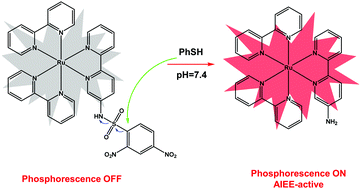A highly sensitive Ru(ii) complex-based phosphorescent probe for thiophenol detection with aggregation-induced emission characteristics†
Abstract
A novel Ru-based phosphorescent probe was designed for the detection of thiophenol using 2,4-dinitrobenzenesulfonate as a sensing unit. The probe exhibited a remarkable off–on type of phosphorescent response towards thiophenol over other commonly encountered metal ions, anions, and aliphatic thiols. The probe was able to work in pure water medium and instantaneously responded to thiophenol with a 36-fold enhancement in 30 seconds. This probe displayed a large Stokes shift (216 nm) and long luminescence lifetime, and the detection limit reached as low as 30 nM. Moreover, detection of thiophenol is based on the thiol-induced cleavage of a sulfonamide linkage to generate a strongly phosphorescent species, Ru-NH2, which showed obvious AIEE activity. Furthermore, the potential for practical applications of this probe has been successfully demonstrated in monitoring thiophenol in real water samples and on test paper.



 Please wait while we load your content...
Please wait while we load your content...